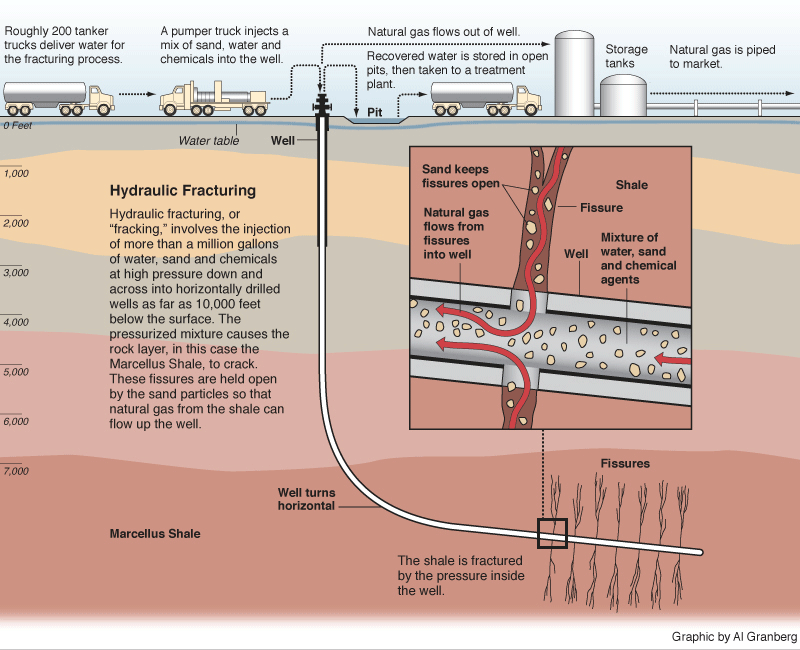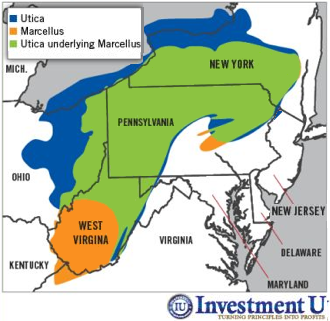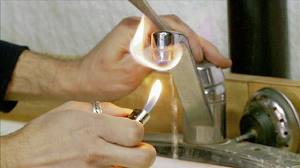Under Construction 
Global Warming | Other Fuel Problems | Renewable Energy | Energy Stats | Green Living | Green Buildings | Transportation
The fracturing technology, in which a mixture of chemicals and water is injected underground with sand at high pressure to crack the earth and release natural gas, made it possible for energy companies to open vast domestic energy reserves across the country and fueled a nationwide boom in drilling activity.

Source: EPA Launches National Study of Hydraulic Fracturing | Common Dreams
Fracking - What is it?
Hydraulic fracturing, involves the injection of tens of thousands to six
million gallons of water at high pressure down and across into horizontally drilled wells into layers of shale 7,000-10,000 feet below the surface.
The water is laced with toxic chemicals and sand or other material
known as "proppant."
 The fluid creates fractures in underground formations and the proppant holds
these fractures open, allowing oil and gas to flow up the drilling pipes.
The fluid creates fractures in underground formations and the proppant holds
these fractures open, allowing oil and gas to flow up the drilling pipes.
Marcellus and Utica Shale are best suited for this.
It has been used in the western U.S. since 1980.
As of 2011, shale gas, the kind that is fracked, made up about 20% of domestic production.
Shale gas is expected to comprise "about 47 percent of U.S. dry gas production by 2035"
In 2011 there were an estimated 11,400 new wells fractured each year. EPA
Where is it?:
The sights of concern to NJ are:
Marcellus Shale in N. Pennsylvania and S. New York which could affect the Delaware River. [map]
Utica shale in a ridge of which lies beneath Sussex and Warren counties NJ.
Pros:
- U.S. Supplies are running out.
- Fracking could give us a 100-year supply
- High-skill jobs. Tax revenue.
- Low, stable energy prices for consumers and industry.
- Natural Gas is cleaner than coal for electrical generation
Fracking across the World Map
Problems:

- Tanker trucks hauling the water needed will add a lot of greenhouse gas to the environment.
- There are many unknown chemicals pumped into the ground for fracking. Some likely candidates are known carcinogens. The EPA considered hydraulic fracturing as exempt from the Safe Drinking Water Act following the act's passage in 1974.
- Some fluid flows back up the well, and is stored in open pits until it can be sent to a treatment plant. The water can pick up radioactive material in the shale - including Radium-226 with a half-life of 1,600 years.
- In the summer of 2008, the federal Bureau of Land Management documented benzene contamination in water wells in Sublette County, Wyoming, the site of one of the nation's largest natural gas fields.
- There have been numerous cases of residents who have experienced a variety of chronic health problems directly traceable to contamination of their air, of their water wells or of surface water.
- Fracking is known to produce airborne pollutants like methane, benzene, and sulfur oxide
See:
Oil and Gas Industry Exemptions.pdf - Environmental Working Group (ewg.org)
LoophoLes for poLLuters - The oil and gas industry's exemptions to major environmental laws
Articles:
Videos:
Hydraulic Fracking Ban in New York and New Jersey Limits Natural Gas Drilling - Energy Digital
Fracking is literally a 'dirty bomb,' says former industry insider (newyork.sierraclub.org)
Fracking Videos (kansas.sierraclub.org)
Investigation of Ground Water Contamination near Pavillion, WY (epa.org)
Fracking Gone Wrong: Finding a Better Way | Earthjustice
EPA Launches National Study of Hydraulic Fracturing | Common Dreams
US Oil consumption
Links:
Sierra Club pages on Fracking:
Stop Fracking! | Sierra Club
Fracking & New Jersey - Fact Sheet
"Fractured Lives: Detritus of Pennsylvania's Shale Gas Boom", Sierra Magazine Jul/Aug 2012
Sierra Club Statement On The Bureau Of Land Management's New Fracking Rules May, 2013
Court Victory For Opponents Of Fracking In California, April 2013
New Lawsuit Aims To Protect More California Public Lands From Fracking April, 2013
North Carolina | Iowa | Michigan
Gasland and Gasland 2, HBO documentaries by Josh Fox focuses on communities in the United States impacted by natural gas drilling and, specifically, a method of horizontal drilling into shale formations known as slickwater fracking.
Proposed upgrade to Transco LNG Pipeline in NJ to move more fracked gas to NY ports.
Fracking at our Sierra Club Page
Return to Environment
last updated 10 Nov 2012
| 